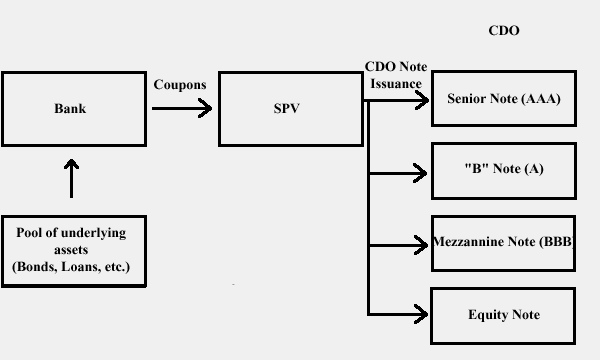CDOs or Collateralized Debt Obligations Definition
Post on: 24 Апрель, 2015 No Comment

Pros, Cons and How They Caused the Financial Crisis
Definition: CDOs, or Collateralized Debt Obligations, are sophisticated financial tools that banks use to repackage individual loans into a product that can be sold to investors on the secondary market. These packages consist of auto loans, credit card debt. mortgages or corporate debt. They are called collateralized because the promised repayment of the loans are the collateral that gives the CDOs value.
CDOs are a special type of derivative. Like its name implies, a derivative are any kind of financial product that derives its value from another underlying asset. Derivatives, such as put options. call options and futures contracts. have long been used in the stock and commodities markets.
CDOs are called asset-backed commercial paper if the package consists of corporate debt, and mortgage-backed securities if the loans are mortgages. If the mortgages are made to those with a less than prime credit history, they are called subprime mortgages .
Banks sold CDOs to investors for three reasons:
- The funds they received gave them more cash to make new loans.
- It moved the loan’s risk of defaulting from the bank to the investors.
- CDOs gave banks new and more profitable product to sell, which boosted share prices and managers’ bonuses.
Advantages
At first, CDOs were a welcome financial innovation. They provided more liquidity in the economy. By allowing banks (and corporations) to sell off their debt, CDOs freed up more capital to invest or loan. The creation of CDOs is one reason why the U.S. economy was so robust until 2007.
The invention of CDOs also helped create new jobs. Unlike a mortgage on a house, a CDO is not a product that you can touch or see to ascertain its value. Instead, the value of a CDO was based on a computer model. Thousands of college, and even higher-level, graduates went to work in Wall Street banks as quant jocks. Their job was to write computer programs that would model the value of the bundle of loans that made up a CDO. Thousands of salespeople were also hired to find investors for these new products.

As competition for new and improved CDOs grew, these quant jocks made more complicated computer models. They broke the loans down into tranches , which are simply bundles of loan components with similar interest rates.
Here’s how that works. Adjustable-rate mortgages often offered teaser low-interest rates the first three years, and in exchange for higher rates later. Borrowers often took the loans, knowing they could only afford to pay the low rates. They expected to sell the house before the higher rates kicked in.
The quant jocks designed CDO tranches to take advantage of these different rates. One tranche held only the low-interest portion of mortgages, while another tranche offered just the portion with the higher rates. That way, conservative investors could take the low-risk, low-interest tranche, while aggressive investors could take the higher-risk, higher-interest tranche. All went well as long as housing prices, and the economy in general, continued to grow.
Disadvantages
Unfortunately, the extra liquidity ultimately created an asset bubble in housing, credit cards and auto debt. Housing prices became unrelated to their actual value, and people bought homes simply to sell them. The easy availability of debt meant people charged too much, and and credit card debt nearly hit $1 trillion in 2008 .
CDOs allowed banks to avoid having to collect on them when they become due, since the loans are now owned by other investors. This made them less disciplined in adhering to strict lending standards, so that many loans were made to borrowers who weren’t credit-worthy — ensuring disaster.
What made things even worse was that CDOs became so complex that the buyers didn’t really know the value of what they were buying. They relied on their trust of the bank selling the CDO without doing enough research to be sure the package was really worth the price. The research wouldn’t have done much good, anyway, because even the banks didn’t know. The computer models based the CDOs’ value on the assumption that housing prices would continue to go up. When they went down, the computers couldn’t price the product.
How CDOs Caused the Financial Crisis
This opaqueness and the complexity of CDOs created a market panic when banks realized they couldn’t price the product, or the assets they were still holding. Overnight, the market for CDOs disappeared. Banks refused to lend each other money because they didn’t want more CDOs on their balance sheet in return. It was like a financial game of musical chairs when the music stopped. This panic caused the 2007 Banking Crisis. The first CDOs to go south were the mortgage-backed securities. When housing prices started to drop in 2006, the mortgages of homes bought in 2005 were soon upside-down.
The first to default were the subprime mortgages. By 2006, the subprime mortgage crisis was well underway. However, most economy-watchers thought (hoped!) it was confined to housing. In fact, some welcomed it and said that housing had been in a bubble and needed to cool down, anyway.
What they didn’t realize was how derivatives multiplied the effect of any bubble — and any subsequent downturn. Not only banks were left holding the bag, but also pension funds. mutual funds and corporations. It was until the Federal Reserve and the Treasury started buying these CDOs that a semblance of functioning returned to the financial markets. Article updated August 2011














